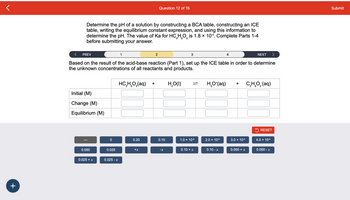Determine the pH of a solution by constructing a BCA table, constructing an ICE table, writing the equilibrium constant expression, and using this information to determine the pH. The value of Ka for HC₂H₂O₂ is 1.8 x 10³. Complete Parts 1-4 before submitting your answer. 2 3 4 NEXT > Two solutions are mixed: 20.0 mL of 0.20 M HC₂H₂O₂ and 20.0 mL of 0.10 M NaOH. Fill in the table with the appropriate value for each involved species to determine the moles of reactant and product after the reaction of the acid and base. You can ignore the amount of water in the reaction. Before (mol) Change (mol) After (mol) -2.0 × 10³ 0 3.0 x 10³ 1 HC,H,O,(aq) + 20.0 -3.0 x 10³ 0.20 OH (aq) 4.0 × 10³ 0.10 → -4.0 × 10³ H₂O(1) 1.0 x 10³ -1.0 × 10³ C,H,O,(aq) RESET 2.0 × 10³
Determine the pH of a solution by constructing a BCA table, constructing an ICE table, writing the equilibrium constant expression, and using this information to determine the pH. The value of Ka for HC₂H₂O₂ is 1.8 x 10³. Complete Parts 1-4 before submitting your answer. 2 3 4 NEXT > Two solutions are mixed: 20.0 mL of 0.20 M HC₂H₂O₂ and 20.0 mL of 0.10 M NaOH. Fill in the table with the appropriate value for each involved species to determine the moles of reactant and product after the reaction of the acid and base. You can ignore the amount of water in the reaction. Before (mol) Change (mol) After (mol) -2.0 × 10³ 0 3.0 x 10³ 1 HC,H,O,(aq) + 20.0 -3.0 x 10³ 0.20 OH (aq) 4.0 × 10³ 0.10 → -4.0 × 10³ H₂O(1) 1.0 x 10³ -1.0 × 10³ C,H,O,(aq) RESET 2.0 × 10³
Chemistry
10th Edition
ISBN:9781305957404
Author:Steven S. Zumdahl, Susan A. Zumdahl, Donald J. DeCoste
Publisher:Steven S. Zumdahl, Susan A. Zumdahl, Donald J. DeCoste
Chapter1: Chemical Foundations
Section: Chapter Questions
Problem 1RQ: Define and explain the differences between the following terms. a. law and theory b. theory and...
Related questions
Question

Transcribed Image Text:Determine the pH of a solution by constructing a BCA table, constructing an ICE
table, writing the equilibrium constant expression, and using this information to
determine the pH. The value of Ka for HC₂H₂O₂ is 1.8 × 105. Complete Parts 1-4
before submitting your answer.
2 3 2
NEXT >
2
Two solutions are mixed: 20.0 mL of 0.20 M HC₂H₂O₂ and 20.0 mL of 0.10 M NaOH. Fill in the
table with the appropriate value for each involved species to determine the moles of reactant and
product after the reaction of the acid and base. You can ignore the amount of water in the
reaction.
Before (mol)
Change (mol)
After (mol)
-2.0 × 10-³
0
3.0 × 10-³
1
HC,H,O,(aq)
20.0
-3.0 × 10-³
2
0.20
OH(aq)
4.0 × 10-³
0.10
3
-4.0 × 10-³
H₂O(1)
1.0 × 10-³
4
-1.0 × 10³
C,H,O,(aq)
RESET
2.0 × 10-³
Expert Solution
This question has been solved!
Explore an expertly crafted, step-by-step solution for a thorough understanding of key concepts.
This is a popular solution!
Trending now
This is a popular solution!
Step by step
Solved in 4 steps with 4 images

Follow-up Questions
Read through expert solutions to related follow-up questions below.
Follow-up Question

Transcribed Image Text:+
Determine the pH of a solution by constructing a BCA table, constructing an ICE
table, writing the equilibrium constant expression, and using this information to
determine the pH. The value of Ka for HC₂H₂O₂ is 1.8 × 105. Complete Parts 1-4
before submitting your answer.
3 2
Initial (M)
Change (M)
Equilibrium (M)
PREV
Based on the result of the acid-base reaction (Part 1), set up the ICE table in order to determine
the unknown concentrations of all reactants and products.
HC,H,O,(aq) +
0.050
0.025 + x
0
0.025
0.025 - x
1
0.20
Question 12 of 15
+x
2
0.10
-X
H₂O(1)
3
1.0 × 10-³
0.10 + x
H,O*(aq)
2.0 × 10-³
0.10 - x
4
+
3.0 × 10.³
0.050 + x
NEXT
C,H,O,(aq)
>
RESET
4.0 × 10-³
0.050 - x
Submit
Solution
Knowledge Booster
Learn more about
Need a deep-dive on the concept behind this application? Look no further. Learn more about this topic, chemistry and related others by exploring similar questions and additional content below.Recommended textbooks for you

Chemistry
Chemistry
ISBN:
9781305957404
Author:
Steven S. Zumdahl, Susan A. Zumdahl, Donald J. DeCoste
Publisher:
Cengage Learning

Chemistry
Chemistry
ISBN:
9781259911156
Author:
Raymond Chang Dr., Jason Overby Professor
Publisher:
McGraw-Hill Education

Principles of Instrumental Analysis
Chemistry
ISBN:
9781305577213
Author:
Douglas A. Skoog, F. James Holler, Stanley R. Crouch
Publisher:
Cengage Learning

Chemistry
Chemistry
ISBN:
9781305957404
Author:
Steven S. Zumdahl, Susan A. Zumdahl, Donald J. DeCoste
Publisher:
Cengage Learning

Chemistry
Chemistry
ISBN:
9781259911156
Author:
Raymond Chang Dr., Jason Overby Professor
Publisher:
McGraw-Hill Education

Principles of Instrumental Analysis
Chemistry
ISBN:
9781305577213
Author:
Douglas A. Skoog, F. James Holler, Stanley R. Crouch
Publisher:
Cengage Learning

Organic Chemistry
Chemistry
ISBN:
9780078021558
Author:
Janice Gorzynski Smith Dr.
Publisher:
McGraw-Hill Education

Chemistry: Principles and Reactions
Chemistry
ISBN:
9781305079373
Author:
William L. Masterton, Cecile N. Hurley
Publisher:
Cengage Learning

Elementary Principles of Chemical Processes, Bind…
Chemistry
ISBN:
9781118431221
Author:
Richard M. Felder, Ronald W. Rousseau, Lisa G. Bullard
Publisher:
WILEY